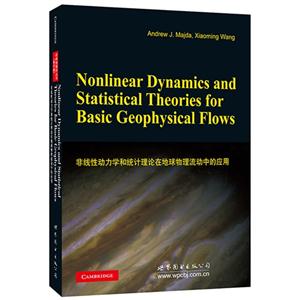Preface1 Barotropic geophysical flows and two-dimensional fluid flows: elementary introduction 1.1 Introduction 1.2 Some special exact solutions 1.3 Conserved quantities 1.4 Barotropic geophysical flows in a channel domain - an important physical model 1.5 Variational derivatives and an optimization principle for elementary geophysical solutions 1.6 More equations for geophysical flows References2 The response to large-scale forcing 2.1 Introduction 2.2 Non-linear stability with Kolmogorov forcing 2.3 Stability of flows with generalized Kolmogorov forcing References3 The selective decay principle for basic geophysical flows 3.1 Introduction 3.2 Selective decay states and their invariance 3.3 Mathematical formulation of the selective decay principle 3.4 Energy-enstrophy decay 3.5 Bounds on the Dirichlet quotient, A(t) 3.6 Rigorous theory for selective decay 3.7 Numerical experiments demonstrating facets of selective decay References A.1 Stronger controls on A(t) A.2 The proof of the mathematical form of the selective decay principle in the presence of the beta-plane effect4 Non-linear stability of steady geophysical flows 4.1 Introduction 4.2 Stability of simple steady states 4.3 Stability for more general steady states 4.4 Non-linear stability of zonal flows on the beta-plane 4.5 Variational characterization of the steady states References5 Topographic mean flow interaction, non-linear instability, and chaotic dynamics 5.1 Introduction 5.2 Systems with layered topography 5.3 Integrable behavior 5.4 A limit regime with chaotic solutions 5.5 Numerical experiments References Appendix 1 Appendix 26 Introduction to information theory and empirical statistical theory 6.1 Introduction 6.2 Information theory and Shannons entropy 6.3 Most probable states with prior distribution 6.4 Entropy for continuous measures on the line 6.5 Maximum entropy principle for continuous fields 6.6 An application of the maximum entropy principle to geophysical flows with topography 6.7 Application of the maximum entropy principle to geophysical flows with topography and mean flow References7 Equilibrium statistical mechanics for systems of ordinary differential equations 7.1 Introduction 7.2 Introduction to statistical mechanics for ODEs 7.3 Statistical mechanics for the truncated Burgers-Hopf equations 7.4 The Lorenz 96 model References8 Statistical mechanics for the truncated quasi-geostrophic equations 8.1 Introduction 8.2 The finite-dimensional truncated quasi-geostrophic equations 8.3 The statistical predictions for the truncated systems 8.4 Numerical evidence supporting the statistical prediction 8.5 The pseudo-energy and equilibrium statistical mechanics for fluctuations about the mean 8.6 The continuum limit 8.7 The role of statistically relevant and irrelevant conserved quantities References Appendix 19 Empirical statistical theories for most probable states 9.1 Introduction 9.2 Empirical statistical theories with a few constraints 9.3 The mean field statistical theory for point vortices 9.4 Empirical statistical theories with infinitely many constraints 9.5 Non-linear stability for the most probable mean fields References10 Assessing the potential applicability of equilibrium statistical theories for geophysical flows: an overview 10.1 Introduction 10.2 Basic issues regarding equilibrium statistical theories for geophysical flows 10.3 The central role of equilibrium statistical theories with a judicious prior distribution and a few external constraints 10.4 The role of forcing and dissipation 10.5 Is there a complete statistical mechanics theory for ESTMC and ESTP?
References11 Predictions and comparison of equilibrium statistical theories 11.1 Introduction 11.2 Predictions of the statistical theory with a judicious prior and a few external constraints for beta-plane channel flow 11.3 Statistical sharpness of statistical theories with few constraints 11.4 The limit of many-constraint theory (ESTMC) with small amplitude potential vorticity References12 Equilibrium statistical theories and dynamical modeling of flows with forcing and dissipation 12.1 Introduction 12.2 Meta-stability of equilibrium statistical structures with dissipation and small-scale forcing 12.3 Crude closure for two-dimensional flows 12.4 Remarks on the mathematical justifications of crude closure References13 Predicting the jets and spots on Jupiter by equilibrium statistical mechanics 13.1 Introduction 13.2 The quasi-geostrophic model for interpreting observations and predictions for the weather layer of Jupiter 13.3 The ESTP with physically motivated prior distribution 13.4 Equilibrium statistical predictions for the jets and spots on Jupiter References14 The statistical relevance of additional conserved quantities for truncated geophysical flows 14.1 Introduction 14.2 A numerical laboratory for the role of higher-order invariants 14.3 Comparison with equilibrium statistical predictions with a judicious prior 14.4 Statistically relevant conserved quantities for the truncated Burgers-Hopf equation References A.1 Spectral truncations of quasi-geostrophic flow with additional conserved quantities15 A mathematical framework for quantifying predictability utilizing relative entropy 15.1 Ensemble prediction and relative entropy as a measure of predictability 15.2 Quantifying predictability for a Gaussian prior distribution 15.3 Non-Gaussian ensemble predictions in the Lorenz 96 model 15.4 Information content beyond the climatology in ensemble predictions for the truncated Burgers-Hopf model 15.5 Further developments in ensemble predictions and information theory References16 Barotropie quasi-geostrophic equations on the sphere 16.1 Introduction 16.2 Exact solutions, conserved quantities, and non-linear stability 16.3 The response to large-scale forcing 16.4 Selective decay on the sphere 16.5 Energy enstrophy statistical theory on the unit sphere 16.6 Statistical theories with a few constraints and statistical theories with many constraints on the unit sphere References Appendix 1 Appendix 2Index




















